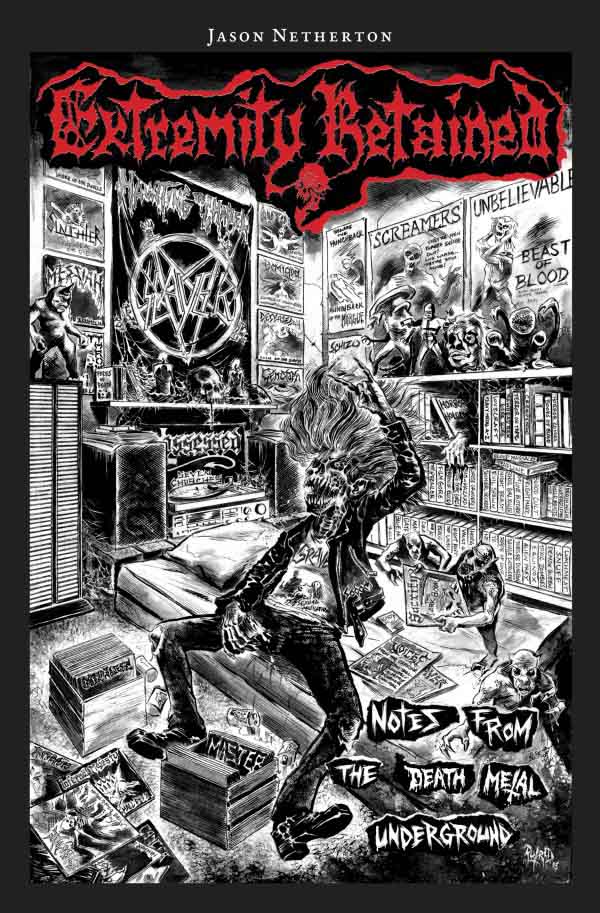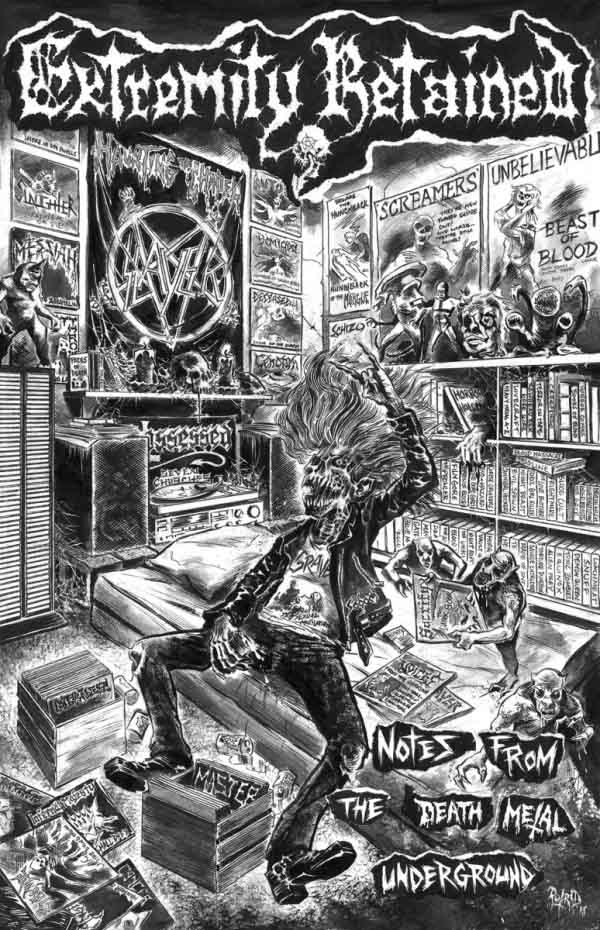
Jason Netherton (Dying Fetus, Misery Index) created his history of death metal called Extremity Retained: Notes From the Death Metal Underground by letting members of the community tell their stories. This book compiles interviews with death metal bands, artists, writers and label owners. It organizes these into five topic areas which makes it easier to find specifics in the book, and by grouping like stories together breaks up the repetition that massed interviews normally have. The result provides a good background in the history and experience of the rise of the death metal genre.
Netherton’s use of topic areas allows band statements to be taken as a whole on the theme and to expand upon it without becoming repetition of similar questions and answers that un-edited interviews tend toward. Some may be put off by the lack of narrative tying these together, but the upside of that situation is that there is little extraneous text outside of what the actors in this scene said themselves. The only weak spot may be that since the highlight is clearly the old school bands, the inclusion of newer bands becomes extraneous when compared with the old.
The following and others contributed to the content of hte book: Luc Lemay (Gorguts), Alex Webster (Cannibal Corpse), King Fowley (Deceased), Stephan Gebidi (Thanatos, Hail of Bullets), Dan Swanö (Edge of Sanity), Doug Cerrito (Suffocation), John McEntee (Incantation, Funerus), Marc Grewe (Morgoth), Ola Lindgren (Grave), Kam Lee (ex-Massacre, ex-Death), Tomas Lindberg (At the Gates, Lock Up), Robert Vigna and Ross Dolan (Immolation), Esa Linden (Demigod), Dan Seagrave (Artist), Rick Rozz (ex-Death, Massacre), Steve Asheim (Deicide), Jim Morris (Morrisound Studios), Terry Butler (Obituary, Massacre, ex-Death), Mitch Harris (Napalm Death, Righteous Pigs), Robin Mazen (Derketa, Demonomacy), Ed Warby (Gorefest, Hail of Bullets), Andres Padilla (Underground Never Dies! book), Donald Tardy (Obituary), Paul Speckmann (Master, Abomination), Phil Fasciana (Malevolent Creation), Tony Laureno (ex-Nile, ex-Angelcorpse), Alan Averill (Primordial, Twilight of the Gods), Alex Okendo (Masacre), and Lee Harrison (Monstrosity).
The topic division of the book begin with the origins of death metal and then branch out to its diversification, and then areas of experience such as recording and touring. The final section addresses the future of metal. The material of most interest to me personally was at the front of the book where the old school bands talked about what inspired them and how the scene came together. It was like witnessing a revolution secondhand. In these sections, the most compelling accounts come from the people who are longest in the game as they are explaining the literal genesis of the process. Within each section, individual speakers identified by band write lengthy revelations to which the editors have added helpful captions. The result makes it easy to read or skim for information. Many of this book’s most ardent readers will find themselves doing a lot of skimming because the information here works as an excellent concordance to many of the other books on death metal or metal history and can reinforce or amplify what you find there.
We were all very much into underground music. Early on we were into Venom, Angel Witch and Motorhead, and later it evolved into bands like Hellhammer, Celtic Frost and Slayer. We wanted to play like them, and that is pretty much why we picked up the instruments in the first place.
With Massacre we were calling the music death metal pretty much from the beginning. We liked a lot of thrash, but to us a lot of it was just a bit too happy and the rhythms were a bit “too dancey.” Of course there were darker thrash albums like Bonded by Blood from Exodus, but even by the first demos we were calling it death metal. I mean, it’s not death metal as you know it today, but those demos were certainly founding releases in the death metal genre in terms of style. Of course, there are no blast beats or anything, but it was a combination of dark rhythms, the dark lyrics, and rough vocals that separated it from thrash. The term death metal had started getting kicked around with Hellhammer/Celtic Frost. We also knew of the Possessed demos, and it was in that tradition that we were referring to ourselves as death metal.
Some of the statements by later bands or bands that are not really death metal seemed like revisionist history but that is to be expected, since every band has to self-promote and include itself in whatever it can. This book utterly shines in the lengthy statements by founders of the genre that explain how it came to be, the thought process at the time and some of the experiences bands underwent. Be ready for blood, vomit and death in the touring section, and prepare yourself for some gnarly old school history in the other parts. By the rules of information itself, it is impossible to craft a metal history that pleases everyone. Extremity Retained: Notes From the Death Metal Underground takes the approach that Glorious Times did and amplifies it by getting longer statements and not relying on pictures, and it adds its unique and vital voice to the canon of books on the history of death metal.
9 CommentsTags: book, death metal history, jason netherton, metal history




